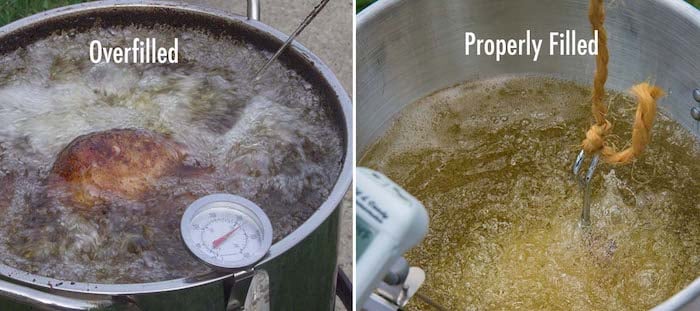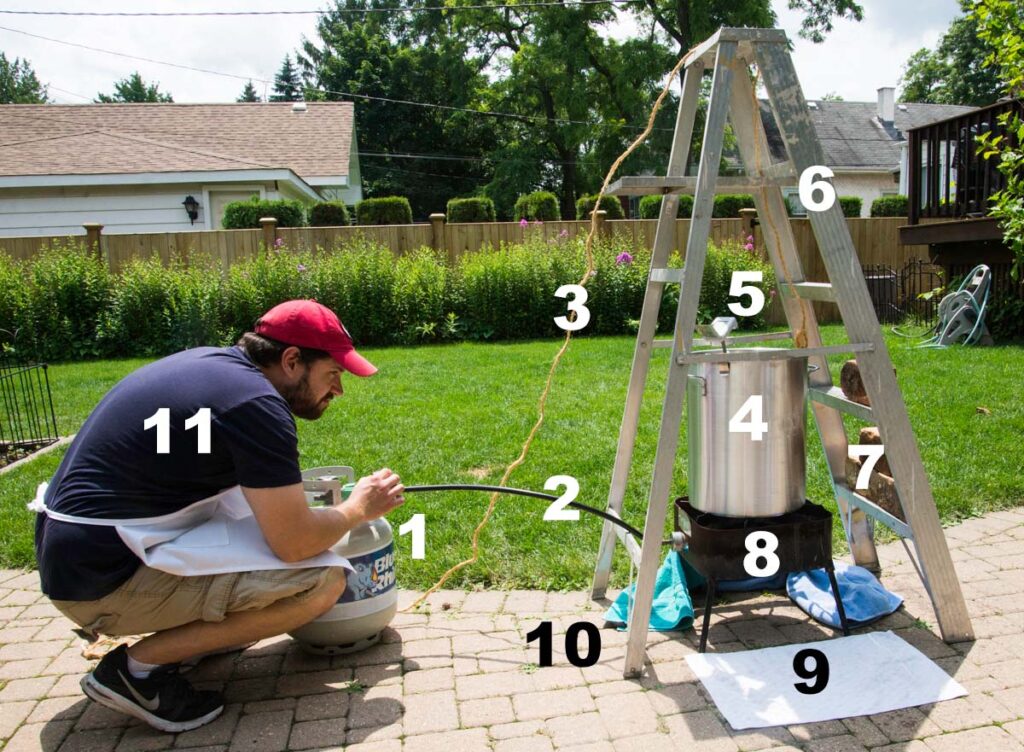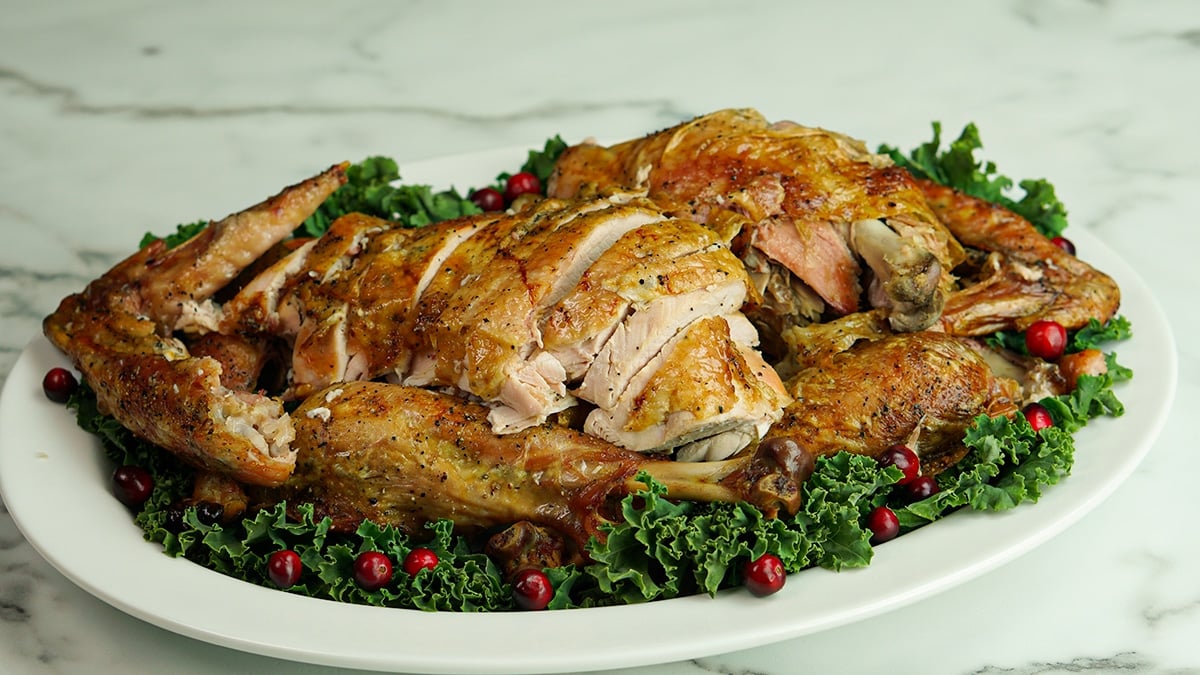WARNING: PLEASE READ THESE INSTRUCTIONS AND ANY INSTRUCTIONS THAT CAME WITH YOUR FRYER THOROUGHLY AND CAREFULLY. IF YOU DO NOT FOLLOW THEM YOU CAN EASILY SUFFER PROPERTY DAMAGE, PERSONAL INJURY, AND EVEN DEATH.
Deep frying turkey is a popular cooking technique because, if done right, it is fast, yields the best crispy skin, juicy meat, and it is mucho macho. But it is also mucho dangerous. Just Google “deep fried turkey disaster.” This is by far the most dangerous way to cook a turkey and ruin Thanksgiving.
Select the right spot. Stay at least 10 feet away from structures that can catch on fire and don’t work under an overhang or a tree. Stay off the grass. The heat and any spilled oil will destroy it and it will not grow back easily. Asphalt can melt. Wood and plastic can catch fire. Work on level concrete or dirt and keep away from children, pets, flying soccer balls, and any other hazards.

You must be absolutely sure the oil will not overflow the pot because if it does, the flame below will surely ignite it and that will set the entire pot of oil on fire. And anything flammable nearby. Make sure that when the bird is fully submerged in oil and there is at least 4 inches of space above the oil level. We’ll explain below how to do this.
Water is the enemy. Do not inject, marinate, or wet brine the bird. Pat the bird dry before dunking it in oil. A wet bird, rain, or snow can cause flying droplets of oil, and scorching steam. Wear heavy gloves, a long sleeve shirt, long pants, and shoes, not sandals.
What causes bubbling, then overflow, then fire? Water. The bird is 75% water and if you take it out of the fridge at 38°F and lower it into 350°F oil, the temperature of the bird will rise rapidly. Near the surface it can easily reach 190°F and start steaming. It can even reach 212°F, the boiling temp. That steam within the oil causes creates large bubbles that burst on the surface aerosolizing the oil. If that oil falls onto the flame it can ignite, and if there are a lot of droplets, there can be a flaming cloud that ignites the surface of the oil in the pot. If this happens, turn off the valve on the gas tank and, place a lid on the pot to extinguish the fire. But that might not work.
Have on hand a dry chemical fire extinguisher. Never use a hose or water to try to douse a grease fire. It will only spread it around and make it worse. Keep a phone nearby with the fire department on speed dial.
Special Equipment

Frying a whole turkey is expensive. You need some special gear. Above is the proper setup.
1) Propane tank. Make sure it is full so you don’t run out.
2) Long hose and regulator to keep the tank away from flame and so you can turn off the gas from a distance if there is a problem.
3) Rope to lower the bird into the oil from a safe distance. On the end of the rope, inserted in the bird is a Lifting hook. It looks like a grappling hook and the stem goes through the cavity while the tines come out the other side and hold the bird from below. Alternatively, a perforated fry, steam, boil, basket with a sturdy handle will do. This is a basket with holes that slips inside the pot and makes it easy to lower and raise birds into and out of the oil.
4) 26 to 32 quart pot. It can also be used for boiling lobsters, crawfish, crabs, shrimp, corn on the cob, potatoes, and even pasta. You can also use it to make mass quantities of barbecue sauce, spaghetti sauce, South Carolina hash, and more. Most pots are aluminum, and a few are stainless. Aluminum works fine for frying, but should not be used for things like crawfish boils or making spaghetti sauce because they can react with acid and salt. Stainless steel is easier to clean and more versatile because it is non-reactive. You can also store the oil in stainless. For bigger birds, you will need a bigger pot, but I do not recommend going over 12 pounds. It is hard to get the interior of the breast cooked without burning the skin on bigger birds. Some come with a spigot at the bottom for draining the oil and then you can use it for a drink dispenser.
5) Oil thermometer. Use a digital thermometer to monitor the oil temp. If the oil is too hot it can smoke and catch on fire or cook the outside long before the inside and dry out the meat. You need a thermometer with a probe long enough to reach the oil and a clip to hold it to the pot. I like the Maverick CT-03 Oil/Candy Fryer Thermometer. You also need a meat thermometer. The best choice is a “leave in” digital thermometer than can be stuck into the breast and left there so you can read the temp as it cooks. If necessary you can get by with a rapid read thermometer but to do it you need to lift the bird out of the oil. A good timer is also useful. I love the Thermoworks Timestick.
6) 6′ Folding step ladder. You really do not want to lower the bird in while standing next to a pot of boiling oil. A random spatter of hot oil can make you drop the bird into the oil and start a disaster. This is a great way to scald yourself and spend the day in the hospital. Put the folding ladder over the pot and lower the bird in with the rope. Another technique is to use a sturdy broom handle and have one person on each end, but the ladder is my choice.
7) Bricks to counterbalance ladder.
8) Propane burner/stand. You want something with wide legs that will not tip easily. You need a long hose to keep the tank well out of harm’s way, and easy for you to reach in case you need to turn off the valve if there is a fire. My favorite is the Bayou Classic SP10 High-Pressure Outdoor Propane Cooker.
9) Towels to catch splatters.
10) Solid base under the whole shebang. Don’t do this on grass.
11) Attendant. You need to be near the apparatus for the entire cook. It’s helpful to have heavy gloves. My favorites, by far, are leather welder’s gloves. It’s a good idea to wear safety glasses, too, in case of splatters.
You can buy a frying kit at the hardware store and get a serviceable cheap aluminum rig. My favorite is the Bayou Classic 32 Quart Stainless Steel Propane Turkey Fryer Kit. It has most of the features I recommend below. Bayou Classic makes a wide variety of excellent fryer kits and parts. They set the standard. If you want to buy the parts separately, here’s what you need and my thoughts on what to look for. Click here to see the lineup of turkey fryer kits and parts on Amazon.
Need More Turkey Tips?

Be amazing this holiday season and serve your guests the best turkey of their lives. Our downloadable eBook Turkey Outdoors Made Easy delivers 25 tested recipes from the AmazingRibs.com team, giving you everything you need to achieve flawless smoked or grilled turkey.
Get the eBook for *FREE* when you buy our rubs and sauces
Dealing with the leftover oil
You can reuse the oil once, but the heat alters its chemistry and it does not keep well once it has been used. In addition, it now contains fats from the bird and burned bits of spices. The best idea is to throw out the oil after each use. But if you want to use it a second time, allow the oil to cool completely then strain it with a fine mesh strainer to remove large chunks of skin and seasoning. Then run it through several layers of cheese cloth or coffee filters. It takes a while. It must be stored in a refrigerator to delay oxidation and rancidity. Don’t store the oil in an aluminum pot. Salt in the oil from the first cook can corrode the metal and spoil the oil. Use a very clean glass or plastic container or a stainless steel pot. It can be kept for 2 to 3 months in the fridge. It may get cloudy in the fridge, this is normal.
When it is spent, do not pour it down the drain. It can easily clog your plumbing or the sewers. You can pour cool oil into a jug, seal it tight, put that in a plastic bag, and toss it in the trash. Some cities have designated places to take cooking oil for recycling where it can be made into biodiesel, soap, cosmetics, pet food, and glue. Google “cooking oil donation [your town]”. Or ask a local restaurant what they do with used fry oil. They might even take it off your hands if you are a regular customer. Many restos have oil drums out back that are picked up by recyclers. The best way to discard it is to mix it with cat litter or sand and then it can go into a trash bag.
Makes:
Takes:
Equipment
- turkey fryer (or a whole kit containing the next four items)
- 24-32 quart stainless steel frying pot
- Perforated fry, steam or boil basket with a sturdy handle
- Lifting hook and turkey rack
- Propane burner/stand
- Full propane tank
- 6 foot folding step ladder and 15 feet of cloth rope
- Bricks
- Timer
- Meat thermometer
- Heavy gloves
- Safety glasses
Ingredients
- 12 pound whole turkey (or up to 18 pounds)
- 4 tablespoons Morton Coarse Kosher Salt (1 teaspoon per pound of turkey)
- 12 quarts peanut oil or other high smoke point oil such as refined canola oil, corn oil, or sunflower oil
These recipes were created in US Customary measurements and the conversion to metric is being done by calculations. They should be accurate, but it is possible there could be an error. If you find one, please let us know in the comments at the bottom of the page
Method
- Safety first. The bird must be fully thawed. Never stuff the bird and remember to remove the giblets and neck from the front and center cavities. Drain all liquid from the cavity. Trim off excess flaps of skin, the tail, and the wing tips. They will burn. Make sure there is an open channel through the body cavity to the neck cavity so you can see daylight on the other side. You need to do this to prevent an air bubble and so you can drain the bird when you are done. Remove the plastic popup thermometer and the plastic truss that holds the legs together.
- Measure displacement. Salt the bird, 1 teaspoon Morton coarse kosher salt per pound of meat. You can use a rub, but much of it tends to wash off and burn, and that means you will get only one use out of the oil. We do not recommend it. If you wish you can inject the bird, but that’s adding water and it tends to leak out the holes creating steam. We do not recommend it. Now lower it into the pot and fill it with room temperature oil until the bird is submerged at least 1" below the surface of the oil and the oil is at least 4" below the lip of the pot. Remove the bird and place it in a baking pan. Insert a probe rated for 350°F or above into the deepest part of the thigh. Don't worry about coating the bird with oil at this time. Meat is about 75% water and oil cannot penetrate it.
- Cook. Preheat the oil to 350°F. Do not take the oil beyond 350°F even if you are in a hurry. The temperature will drop quickly when the bird takes a bath in it and then it will slowly build back up. Turn off the flame and slowly lower the bird in. Then you can turn the flame back on. Pull up a lawn chair and a good book., Never leave the fryer unattended. Do not put a lid on during cooking. Steam can condense on the lid and water can drip back into the oil and rapidly vaporize and blow off the lid.
- Is it done yet? Allow 3 to 5 minutes per pound. Turn off the flame and slowly lift the bird out and spot check the internal temperature. Dark meat is best at about 170 to 180°F and white meat at 160°F so you can remove the bird when the breasts hit 155°F in the center. When the bird is done, turn off the flame and slowly lift the bird out and let it drain into the pot. Place it in a baking pan. Let it cool about 10 minutes before carving.




High quality websites are expensive to run. If you help us, we’ll pay you back bigtime with an ad-free experience and a lot of freebies!
Millions come to AmazingRibs.com every month for high quality tested recipes, tips on technique, science, mythbusting, product reviews, and inspiration. But it is expensive to run a website with more than 2,000 pages and we don’t have a big corporate partner to subsidize us.
Our most important source of sustenance is people who join our Pitmaster Club. But please don’t think of it as a donation. Members get MANY great benefits. We block all third-party ads, we give members free ebooks, magazines, interviews, webinars, more recipes, a monthly sweepstakes with prizes worth up to $2,000, discounts on products, and best of all a community of like-minded cooks free of flame wars. Click below to see all the benefits, take a free 30 day trial, and help keep this site alive.
Post comments and questions below
1) Please try the search box at the top of every page before you ask for help.
2) Try to post your question to the appropriate page.
3) Tell us everything we need to know to help such as the type of cooker and thermometer. Dial thermometers are often off by as much as 50°F so if you are not using a good digital thermometer we probably can’t help you with time and temp questions. Please read this article about thermometers.
4) If you are a member of the Pitmaster Club, your comments login is probably different.
5) Posts with links in them may not appear immediately.
Moderators